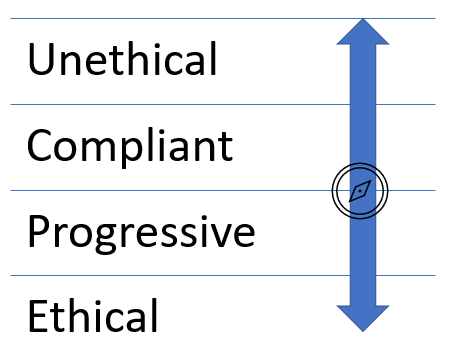Ethical Resilence
Ethical Resilience

What is Ethical Resilience?
Most organisations have an ethical code of conduct and a compliance code of practice that are pillars of business decision-making processes, planning, and operational actions. Most would interpret having these codes of practice as an ethical approach to business.
Ethics provides guidelines, about what is right and what is wrong and what is valued or not, whereas law/compliance is about what is lawful and what is unlawful. By its very nature ethics is subjective; whereas law defines general principles in society what is allowed or forbidden, and the kind of penalty incurred if the law is broken.
The distinction between ethics and sustainability/CSR is also worth considering; ethics is about morally correct behaviour, whereas sustainability /CSR is about risk, reputation, resilience, and responsible outcomes that go beyond compliance requirements.
In most organisations the leadership team brings to life their organisational code of conduct. Their actions and behaviour set the tone for the organisational approach. This approach consequently sets the norms and expectant behaviours that become part of the organisational culture. The culture in turn determines the ethical values, rules, and procedures that will be followed and the leniency to stray away from it.
Ethical Resilient Decision Making Paradigm
In the Ethical Resilient decision-making paradigm, decision-makers draw upon their consciousness ( their moral compass), the culture of the organisation, the context of the internal and external environment, and the purpose they wish to exact to determine the approach they wish to take.
The resulting approach of decision-makers can take any of four paths, termed as the Continuum of Ethical Approach. Across an organisation all four paths can be simultaneously operating, depending on the decision-making process employed at the time in a function or department or at the board level.
Continuum of Ethical Approach.
The Continuum of Ethical Approach stages are defined as follows:
1. Unethical: An approach without morals, where anything is acceptable, and do whatever it takes to win including breaking or curtailing the law e.g. corruption, cheating, etc.
2. Compliant – An approach that works within the parameters of the law and the code of practice of the organisation.
3. Progressive – An approach that works beyond compliance that puts into place propositions such as sustainability, CSR, and an ethical approach.
4. Ethical - An approach where ethics is at the core of every aspect of the organisation from purpose, culture, consciousness, stakeholders, and operations – to do right and cause no harm or wrong.
Volkswagen Group ‘dieselgate scandal’
The important point here is that an organisation can be on many paths at the same time on the Continuum of Ethical Approach, for example, the Volkswagen Group (VW) ‘dieselgate scandal’ where the use of sophisticated software “defeat devices” installed in VW cars to indicate that pollution emissions were reduced when they are not. In September of 2015, the United States Environmental Protection Agency accused Volkswagen of deliberately rigging 482,000 VW and Audi cars with 2-liter, four-cylinder engines with a “defeat device” to evade the higher demands of the Clean Air Act (Woodyard, 2015).
As one division of VW was making a decision that was noncompliant and unethical whilst at the same VW was showcasing its 2014 Sustainability report stating: “There are many definitions of CSR, but we see it as our continuing commitment to behave ethically and contribute to economic development while improving the quality of life of our staff and their families, as well as of the local community and society at large. And more recently they stated: “Our aim is to become a role model when it comes to integrity and compliance.” This illustrates the Continuum of ethical approach that can vary from one function to the next. This will be a reality in most organizations and governments.
Ethical Resilience defined
Ethical decision-making refers to the process of evaluating and choosing among alternatives in a manner consistent with ethical principles. In making ethical decisions, it is necessary to perceive and eliminate unethical options and select the best ethical alternative. By combining ethics and sustainability, it possible to reach a refined approach that can be termed as Ethical Resilience.
Ethical Resilience is the ‘morally right’ precautionary approach to ethics, sustainability, and resilience that is interconnected and merged with the economic, equity, and ecological aspects of a system. Whereas Unethical resilience is an amoral approach to ethics, sustainability, and resilience. With reference to the Continuum of ethical approach, Ethical resilience lies between the Progressive and Ethical pathways ( see figure 3 below).
When Ethical Resilience is applied, decision-makers (governments or organisations) choose to specifically build spare capacity and redundancy for people (including health) and Nature to deal with shocks and linked events on an ethical basis.
Ethical Resilience and Supply chains
Organisations find that as the supply chain gets deeper, they lose control over the governance and operational management. This allows the higher-tier suppliers to take their own approach to Ethical Resilience in relation to the organisations service or product.
Supply chains narrowly focus on predictable operations. An Ethical Resilience Approach would open their horizon to the three paths in parallel as below.
Path 1 - predictable operations, running the supply chain in the lean and cost-effective mode as per now.
Path 2 - building Ethical Resilience providing additional agility or reserve capacity for people and nature
Path 3 - testing innovation for new models and solutions – circular and natural economy approaches.
Ethical Resilience is an imperative
The focus of this paper is to demonstrate that Ethical Resilience is imperative to survive and thrive. The paper provides examples where choices are made at a macro level (governmental) and a micro-level (organisational) and relates it to three key aspects of the economy, equity, and ecosystem with reference to the Covid19 era.
To build Ethical Resilience requires assimilation, addition, and/or substitution. This decision is made by leaders and is dependent on the ethics, values, and culture of the country or organisation. For Ethical Resilience to be applied, good governance is a prerequisite. Ethical decisions are venerable to corruption. For example, a choice will be made in the distribution of capital amongst competing demands. If Ethical Resilience is applied, say, at a macro level, capital resources are shifted. In this situation the government can choose between defence versus people/nature; at the Micro level, an organisation can choose between lean efficiency versus dynamic community or ecosystem investment.
Given the cost of disaster recovery, there is a clear economic case for investing in developing an Ethical Resilience culture that develops agile sustainable systems. However, it remains an area of underinvestment both in industry and for governments as this paper highlights.
As an aside we note that ESG offers the potential for an Ethical Resilience Approach at the micro-level; the governance element allows a self-interest “ethical dimension” for investors and capital.
Objectives that are Ethically Resilient are set out in the SDGs. References are highlighted in the SDGs, as follows:
• SDG 1 (No Poverty) sets out “to end poverty in all its forms”. One of its targets is to “build the resilience of the poor and those in vulnerable situations and reduce their exposure and vulnerability to climate-related extreme events and other economic, social and environmental shocks and disasters”.
• SDG 9 (industry, innovation and infrastructure), has as a target to “build resilient infrastructure”.
• SDG 11 (Sustainable Cities and Communities) aims to “significantly reduce” the number of people killed or harmed by disasters, including protecting those most vulnerable to natural hazards. It also aims to “substantially decrease the direct economic losses” that such disasters cause.
• SDG 13 (Climate Action) calls for “urgent action to combat climate change and its impact”. One of its targets is to “strengthen resilience and adaptive capacity to climate-related hazards and natural disasters in all countries”.
In addition to these explicit goals and targets, the aim to make the world’s poorest and most vulnerable better able to withstand and recover from shocks and disasters runs through the SDGs and their promise to “leave no one behind.” Equity, when applied to opportunity, seeks to give all the chance to make it to the front
Ethical Resilience at the Macro Level
Are there ways to reallocate funds to reinforce Ethical Resilience? The “Guns and Butter Theory” in simplistic terms references the relationship between a nation's investment in defence versus civilian services, a nation has to choose between two options when spending its finite resources. Hermann Göring in 1936 unerringly stated that “Guns will make us powerful; butter will only make us fat.” President Dwight D. Eisenhower decades later on April 16, 1953, stated “Every gun that is made, every warship launched, every rocket fired signifies, in the final sense, a theft from those who hunger and are not fed, those who are cold and are not clothed. This world in arms is not spending money alone. It is spending the sweat of its labourers, the genius of its scientists, the hopes of its children.”
There is one example: Costa Rica abolished its army in 1949, it has political stability and economic prosperity and The Happy Planet Index ranked it No. 1 in the world. It has managed to develop a strong economic and coastguard relationship with the USA. It has used the savings from defence spending to improve education, health care, and a social safety net. Costa Rica spends a higher proportion of gross domestic product (GDP) than the Organization for Economic Cooperation and Development (OECD) average on its universal healthcare. There are still issues with wealth distribution and their ecological footprint. However, the government has used taxes collected on the sale of fossil fuels to pay for the protection of forests. In 2015, the country was able to produce 99% of its electricity from renewable sources to become carbon neutral by 2021. It has also coped with Covid19 better (see above).
Ethical Resilience at a micro-level: the opportunity to re-build Supply Chains post Covid19.
People today are taught to learn specifics when they should also be focused on the holistic nature of things. This narrow learning is the reason, we do not acknowledge the phenomenon of shocks until after they occur. “We are not open enough to rewarding those who can imagine the impossible” (Taleb, 2007) . For example, Supply chains narrowly focus on predictable operations. An Ethical Resilience approach would open up their horizon to three paths in parallel as below.
• Path 1 - predictable operations, running the supply chain in the lean and cost-effective mode as per now.
• Path 2 - building ethical resilience providing additional agility or reserve capacity for people and nature
• Path 3 - testing innovation for new models and solutions – circular and natural economy approaches.
How might an Ethical Resilient supply chain look in the future?
At an economic level, understanding the broader risk and opportunities, building in redundancy and spare capacity e.g. onshore/near shore. Plan to postpone i.e. design products and processes to incorporate postponement as an option. For Equity & Ecosystem, change the approach to people and nature (applications of SDG) at the hub. Cross-industry communication and collaboration to accelerate circularity, digital, tech, and analytics.
Go out beyond tier one or two to build a culture of caring for vulnerable people and nature. Continuous communication with employees, suppliers, and communities and implement lessons learnt fast rather than waiting.
Learnings and going forward with Ethical Resilience
Leadership
• Learn the concept of ethical business and bring to life the code of conduct as part of every governance and decision-making process. Understand the Continuum of Ethical Approach and aligning the organisations decisions to the code of conduct.
• Government and organisational leadership will have to be overt on developing Ethical Resilience culture by reallocating resources and implement good ethical governance.
• Build value-based strategies incorporating ethics.
• Support collaborative learnings from the past that apply Ethical Resilience to future shocks.
• Provide technical and expert support to the dissemination of knowledge and evidence of the successful application of Ethical Resilience.
• Engage in SDGs leadership at a strategic and tactical level, not as a marketing gimmick e.g. mapping.
• Not leaving the most vulnerable people behind through policy and investment in people.
Risk
• A singular lens of risk and materiality is not sufficient in designing policies and strategies - a holistic multimodal approach is needed placing vulnerable people and nature as a priceless core. A collaborative practice to promote ethical redundancy for stress events.
• Learning from past events and infusing current learnings is essential both at a macro and micro level.
• Strengthen the Ethical Resilience cultural approach through collaboration with other relevant stakeholders.
• Working with all major stakeholders to update risk assessments and resilience strategies.
Climate Change
• Future climate emergency-related events require the application of Ethical Resilience.
• Protecting and enhancing the ecosystem will help us address the climate emergency to mitigate the increasing risks from natural hazards like floods and storms.
• Transitioning strategies of adaption and climate change incorporating priceless nature at the centre.
SDG & ESG
• Governments, businesses, and communities have shown that they can act with speed, urgency, and for the greater good.
• Implement SDGs at a strategic, tactical, and operational level with clear accountability and monitoring.
• Corporates SDG’s will have to align to ESG criteria and Ethical Resilience outcomes for investors and capital requirements.
• Accounting for natural capital both at a macro and micro level.
• Monitoring and measure resilience and SDG results, providing options that can be adopted in the future.
• View the SDG through the lens of ESG. SDGs should be aligned to ESG criteria and vice versa for investment and capital requirements.
Opportunities
• Digitisation and Circular economy aspects will aid Ethical Resilience cultures by formalising new ways of working. They must respect human rights and natural systems. Sharing technical and expert findings and providing ways to disseminate the knowledge
• Adopting a portfolio approach to Ethical Resilience dissemination, articulating how different sectors and areas will work together to build resilience and sustainability.
Final Remarks
Covid19 disturbances and delays will continue even after business growth resumes. Countless reviews have been and will be undertaken to understand what went wrong? and how to overcome the next crisis? The consumption economic model is not going to change; therefore, actions need to fit within this spectrum. For a system to exist and thrive it requires the utility of an Ethical Resilience culture.
The role of Governments and Organisations is to incorporate Ethical Resilience as an interrelated concept, not as a separate channel. They must institute a culture that values nature and life, which focuses on future stresses for climate-related events. In the meantime, adaptation strategies should be pursued.
For Ethical Resilience to be applied, good governance is a prerequisite. The choice and the balance is between excessive profitable consumption v priceless nature/ people. The strategic direction is dependent on the leadership, values and culture of the country or organisation. For example, resources and funding for SDGs are urgently required at a macro and micro level.
Finally, a major positive has been that governments, businesses, and communities have shown that they can act with agility, speed, urgency and for the greater good. This globally shared experience has created a value aspect of culture that should be enacted on faster before the ‘normal’ is back. The next major global health crisis waiting in the wings is predicted to be Antimicrobial Resistance (AMR) - how prepared are we? Or will it be something else?
References
- https://eu.usatoday.com/story/money/cars/2015/11/20/vw-volkswagen-chronology-emissions/76122812/
- https://www.volkswagenag.com/en/sustainability.html
- https://icai.independent.gov.uk/wp-content/uploads/Building-resilience-to-natural-disasters-ICAI-review.pdf
- Radio broadcast (1936), as quoted in The New Language of Politics: An Anecdotal Dictionary of Catchwords, Slogans, and Political Usage (1968) by William L. Safire, p. 178 as quoted in https://en.wikiquote.org/wiki/Hermann_G%C3%B6ring
- https://en.wikipedia.org/wiki/Chance_for_Peace_speech
- http://happyplanetindex.org/countries/costa-rica
- The Black Swan Nassin Nicholas Taleb, 2007
Acknowledgements
Richard Andrews, Portia Bangerezako, Simon Brown, Mark Chadwick, Robin Dickinson, Julika Dittrich, Mireia Ferre, Caroline Haycock, Steve Laking, Carolin May, Matthew Orman, Tarran Poonaji, Sanjeev Raghubi, Richard Swannell, Gill Thorpe, Gabriella Zepf

